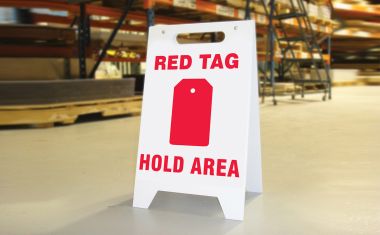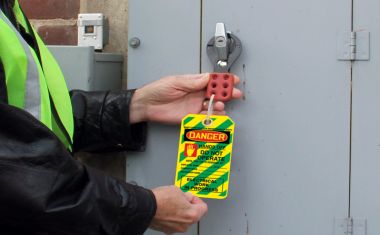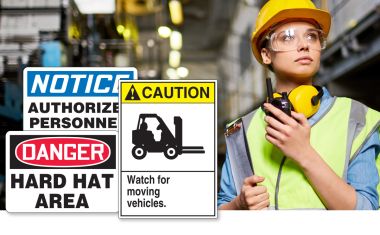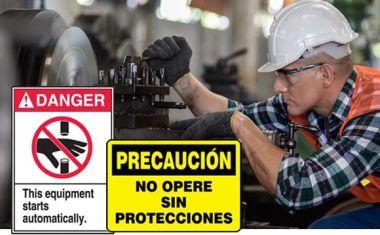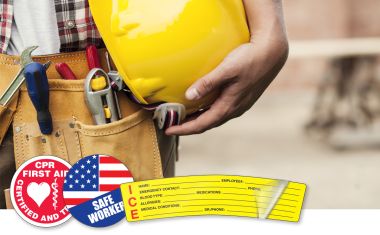Lockout Tagout (LOTO): A Comprehensive Guide
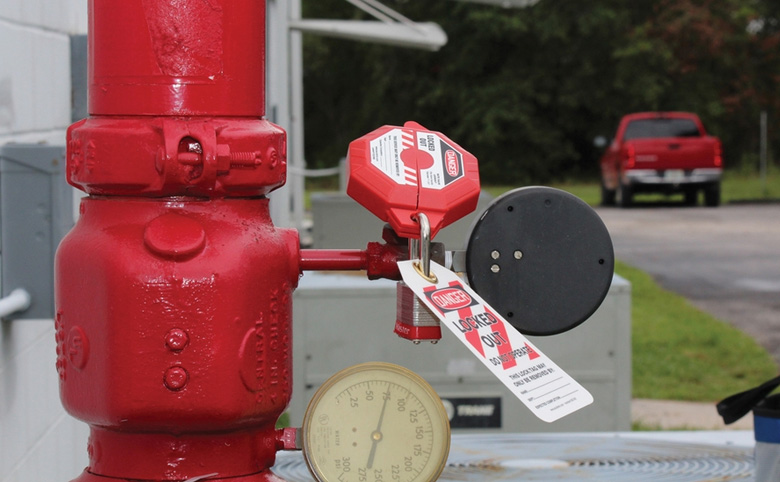
Lockout Tagout (LOTO) is a system that prevents the unexpected start-up of equipment or machinery during service or maintenance procedures. A successful lockout/tagout program safeguards workers from injury by blocking incoming energy and releasing stored energy, making it impossible for devices to turn on, run or move.
Training employees on detailed LOTO protocol is vital to protect everyone who works in an industrial environment. We created this comprehensive guide to lockout tagout systems to help you understand and implement an effective program that protects your employees from potentially dangerous equipment.
Lockout/Tagout Overview and Background
Lockout/Tagout refers to safety procedures that ensure dangerous machines do not experience unexpected energy bursts that cause injuries to workers during maintenance tasks. It requires the isolation of all energy sources to render equipment inoperable when service is necessary. A detailed, written plan protects employees from severe injuries or fatalities on-the-job.
What Is "Lockout/Tagout" and What Does It Mean?
Lockout/Tagout (LOTO) refers to the protocol for correctly shutting down equipment when repairs or maintenance are necessary. These procedures and systems protect employees from potential injuries or death by ensuring machines are inoperable and do not have any stored energy that may cause unintended start-ups.
Lockout devices lock machinery with a key or combination to block potential hazardous energy release, preventing unintentional start-ups.
Tagout systems alert workers and others in the area that they may not use or operate equipment until authorized personnel removes the warnings.
What Is Hazardous Energy?
Any power source that poses a potential danger to workers is hazardous energy. Failure to effectively manage stored energy within machines can cause an unexpected discharge of power, leading to workers' injuries or fatalities. Some types of hazardous energy include:
- Electrical
- Hydraulic
- Pneumatic
- Radiation
- Mechanical
- Thermal
- Chemical
What Are the Damaging Effects of Hazardous Energy?
If not correctly discharged, hazardous energy can release suddenly, causing a power surge that turns on or moves equipment. An unexpected start-up during maintenance activities can result in severe or fatal injuries to people working on or near the machinery, including:
- Electrocutions
- Burns
- Fractures
- Lacerations
- Amputations
- Crushing injuries
- Paralysis
How Can You Control Hazardous Energy?
Lockout is the most reliable method to protect industrial workers from dangerous power sources. The use of a lockout device puts systems in a zero energy state, eliminating the potential hazards of stored energy. Authorized managers must identify all energy sources and discharge any dangerous remaining power to keep workers safe from perilous equipment or machines.
Who Is Responsible for Lockout Tagout?
A manager is responsible for organizing and implementing all energy control procedures. The protocol identifies and details the steps involved for all related workers, machines and processes. A trained and authorized employee executes the protocol when equipment requires servicing. Industries must train all affected employees on the correct methods for maintaining safe working conditions.
What Is the Purpose of a Lockout Tagout?
A lockout/tagout procedure aims to protect employees from harm while performing service or maintenance tasks on machines. An effective plan ensures the release of stored energy that could unexpectedly start equipment while workers perform repairs.
Regulations & Standards
The Occupational Safety and Health Administration regulates procedures and practices for disabling equipment to control hazardous energy release. Businesses need to follow all standards and procedures to prevent accidents that could cause significant harm to staff members.
What Is the Osha Standard for Lockout Tagout?
OSHA requires the adoption and execution of systems and plans to disable equipment altogether while workers repair or service devices. This standard dictates safety procedures to isolate the machinery from all power sources, preventing the release of potentially hazardous energy.
What Are Osha's Requirements?
OSHA standards dictate safety procedures to isolate the machinery from all power sources, preventing the release of potentially hazardous energy.
General Industry 29 CFR 1910.147: This section states that employers must establish a plan and employ systems that protect workers when repairing machinery. This standard involves attaching suitable energy-isolating lockout and tagout devices to equipment, preventing stored energy from discharging suddenly.
Construction 29 CFR 1926.417: This regulation states that workers must appropriately tag all deactivated controls during maintenance tasks to warn and inform others of the process.
What Must an Energy-Control Procedure Include?
Procedures for hazardous energy management must detail the following components:
- The scope of the process
- The purpose of the steps
- The personnel authorized to execute the procedures
- The required practices
- The methods used to ensure safety and compliance
- The devices needed to control the energy sources
Worker Obligations
Employers must train all employees on the necessary processes and tasks involved with LOTO safety procedures.
What do you do before starting service or maintenance activities?
Before anyone begins work on a lockout-out or tagged-out machine, an authorized employee must verify that the equipment's power sources are isolated correctly. They must also confirm there is no remaining stored energy within the system.
What do you do before removing lockout or tagout devices and re-energizing machines?
The OSHA standard requires the following:
- An authorized employee must inspect the machinery to ensure all components are operational and unimpaired.
- The same employee who attached the lockout and tagout devices removes them from the equipment.
- The employee informs workers that the lockout/tagout methods have been removed and asks them to clear the area.
When should you use lockout?
Workers must employ LOTO procedures under the following circumstances:
- The equipment requires repair, cleaning or service.
- Operators must work near the hazardous areas of the machinery.
- Someone must set up or install new equipment.
- A worker needs to replace a machine part.
- A supervisor must perform an equipment inspection.
How do you determine if an energy-isolating device can be locked out?
You can lock out equipment if it has a built-in locking mechanism, has a hasp to attach a lockout device, or can be locked without impairing or altering the energy control ability.
Can you use tagout devices instead of lockout tools?
As this method does not provide the safety of lockout, you should rarely use tagout by itself. Tags are warning systems and do not stop the energization of equipment. If an employer can prove that a tagout fully protects workers or there is no place to position a lockout device on the machine, you can use a tagout method without a lock.
What are the required standards for lockout/tagout devices?
Proper LOTO procedures as outlined by the OSHA standard for The Control of Hazardous Energy are as follows:
- Employers identify hazardous energy sources and devise detailed plans to keep workers safe.
- Employers ensure the proper execution of the required procedures.
- Managers need to train all employees on the importance, purpose and steps of the lockout/tagout program.
- Authorized personnel must review the safety protocol annually.
What if you need power to test or position equipment?
If testing the machinery requires energy, all employees must clear the area during the inspection. If workers must remain near the equipment to complete the test, employers must use alternate safety measures, such as:
- Plexiglas barriers
- Cameras
- Employee restraints
- Two-hand control devices
Lockout/Tagout OSHA Compliance
In the United States, OSHA requires five elements for complete LOTO compliance:
- LOTO program with detailed policies and systems
- Training programs for all relevant employees and managers
- Documentation of lockout/tagout procedures
- Lockout/tagout devices to ensure safety
- Annual review of LOTO program
Quick Lockout Tagout Device Definitions and Use Cases:
Cable Lockouts: A versatile device with a long cable that goes around various isolating components and secures with a padlock.
Chain Lockouts: Chains offers a way to keep people out of large areas that need to be locked out.
Circuit Breaker Lockouts: Electrical isolation locks for circuit breakers.
Energy Source Identification:Â Identify equipment names and energy sources with these safety tags.
Hasps: These devices lock out a single energy control on electrical equipment and machines.
Lock Boxes: Safety devices for ensuring lockout keys are not accessible until workers complete all tasks.
Lockout Center Boards: Store LOTO supplies in one place to ensure compliance with safety protocol.
Lockout Documentation: Training forms, booklets, binders and other documentation to explain proper procedures.
Lockout Kits: These collections provide access to necessary safety devices and tools.
Lockout Training: Booklets to supplement your training program and remind workers of LOTO processes.
Padlocks: Trained team members attach these by hand to secure lockout devices.
Plug Lockouts: These tools stop electric currents from energizing machinery by preventing plugs' insertion into a wall outlet.
Security Seals: Tamper-evident seals to add an extra layer of security.
Switch Lockouts: Removable rotary or push-button switch covers to prevent access to controls.
Valve Lockouts: A lockout device to secure the operational portion of a valve.
Worksite Lockouts: These items warn people of dangers and prevent unauthorized access to specific areas.
Osha Lockout/Tagout Color Codes
OSHA does not require specific color codes for LOTO, but it recommends the following:
Orange: Use orange for warning signs.
Yellow: Signs and safety tags in this color designate caution.
Red: Use devices in this color to indicate danger.
Fluorescent orange: Choose this color for safety signs and markers to label biological hazards.
Lockout Tagout Program / Steps
Develop a comprehensive, written lockout/tagout program to ensure worker safety.
Detail the specific steps for each type of equipment and procedure.
Locate and label all energy isolation points with permanent tags.
Train all affected employees, authorized personnel and workers in the area of hazardous machinery to know and carry out safety procedures.
Conduct periodic audits and inspections.
Utilize secure lockout/tagout devices.
Perform regular reviews of the LOTO program and make adjustments as necessary to maintain optimal safety.
Safety Steps when working with Electrical Devices
Disconnect the electrical installation from live parts on all poles.
Prevent accidental re-connection by replacing fuses with lockout devices.
Verify the installation is dead with voltage detectors or other testing equipment.
Earth relevant parts and then connect the earthing system and cables with short-circuiting devices.
Protect against adjacent live elements.
Safety Steps when working with Energy Sources
Identify the specific type and location of equipment, determine the procedure and detail the steps and energy sources.
Notify all affected employees of the timing and scope of the work processes.
Explain the actions for shutting down machinery in detail to ensure the correct sequence for safety.
Disconnect all sources of energy. Write out detailed instructions for the procedures to follow.
Discharge any remaining hazardous energy and secure any other equipment that may be affected before beginning work.
After disconnecting primary and secondary energy sources, test to ensure the lockout procedure is successful. Clear the area before attempting to start equipment. Once you verify the machine is off, attach a lockout or tagout device.
Safety Steps When Working With Vehicles
Notify all relevant workers of upcoming work.
Isolate the vehicle from all energy sources.
Shut down the car using standard procedures.
Attach lockout/tagout devices to ensure safety.
Verify the energy isolation is successful.
Safety Steps When Working With Machinery
An authorized employee identifies the hazardous energy sources and determines the process for controlling them.
Notify all employees that may be affected by the shutdown, not just those performing service tasks.
Release any stored energy from the equipment.
Shut down the machine or equipment.
Isolate the machine from all energy sources.
Apply lockout and tagout devices to ensure equipment stays in a safe position.
After completing the steps above, double-check to make sure machinery is correctly de-energized and ready for service.
Taking the essential steps to ensure safety in the workplace is crucial for businesses. Lockout/Tagout procedures are a vital part of a comprehensive protection plan. A detailed strategy trains employees on the proper steps for safely servicing equipment. It warns and notifies everyone affected of the work to be done and prevents potential worker injuries and deaths. Written policies are easy for managers and authorized employees to implement, keeping everyone on-site safe. The effort and time it takes to implement a complete program are well worth the long-term safety benefits.



